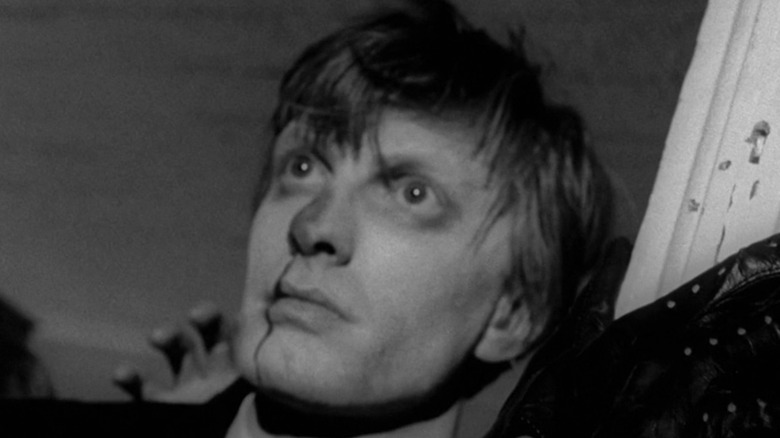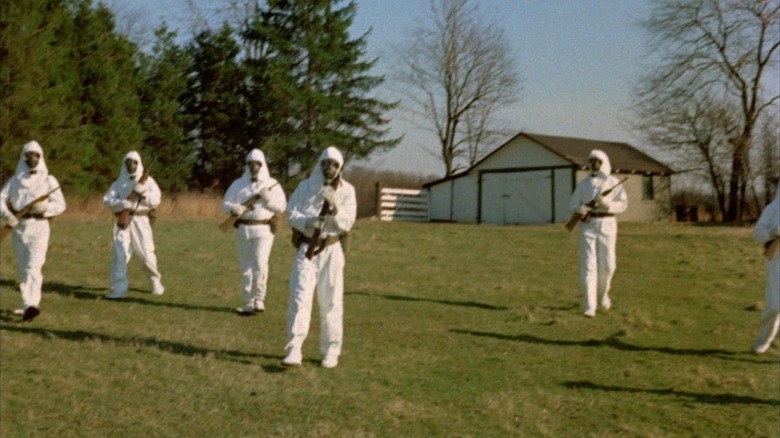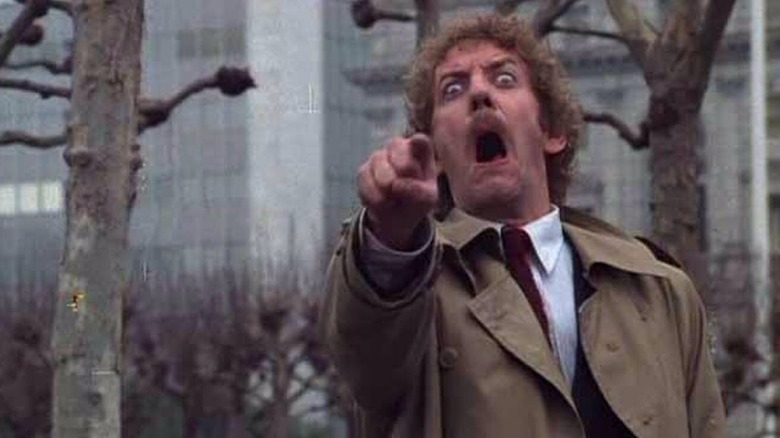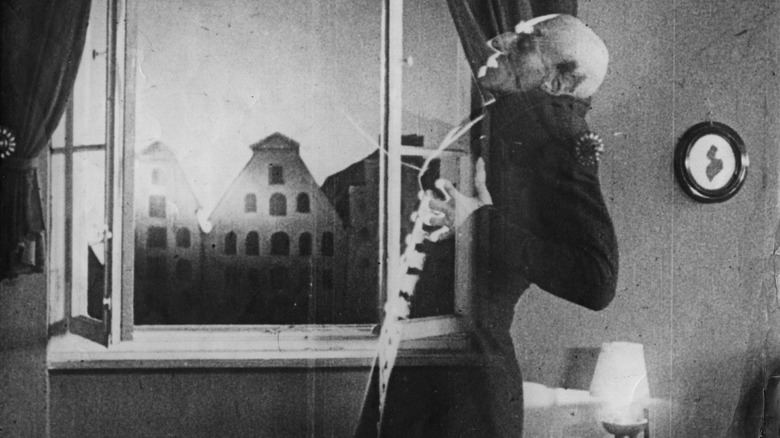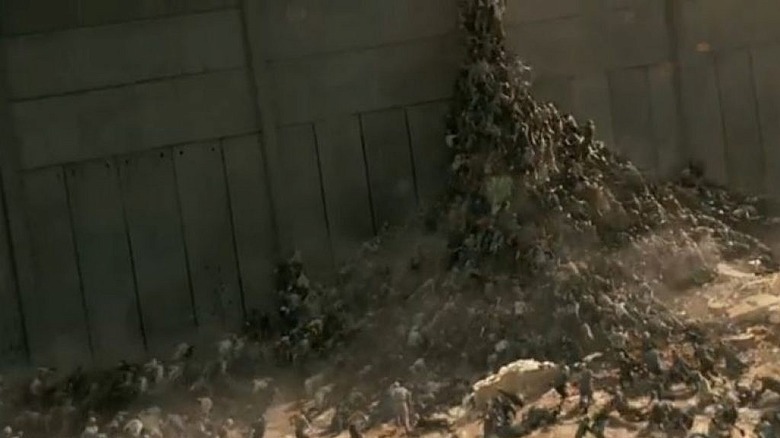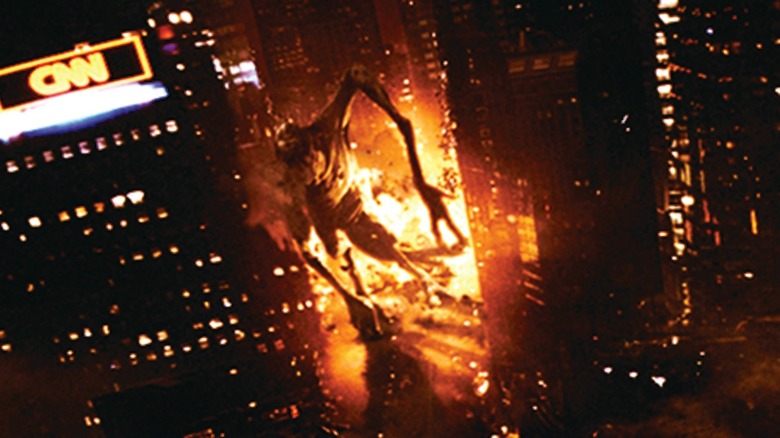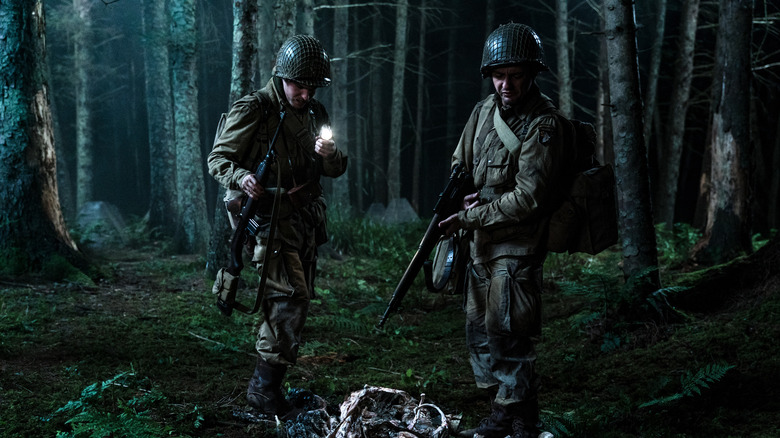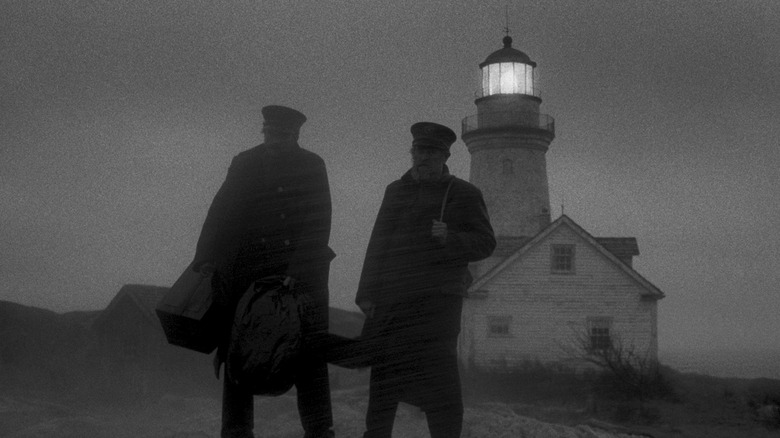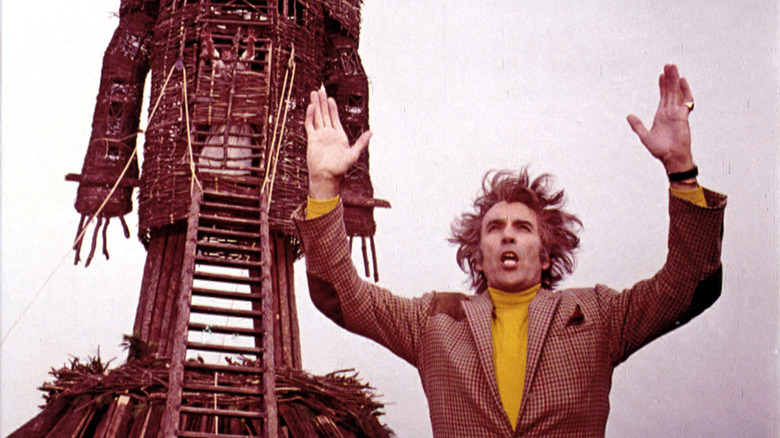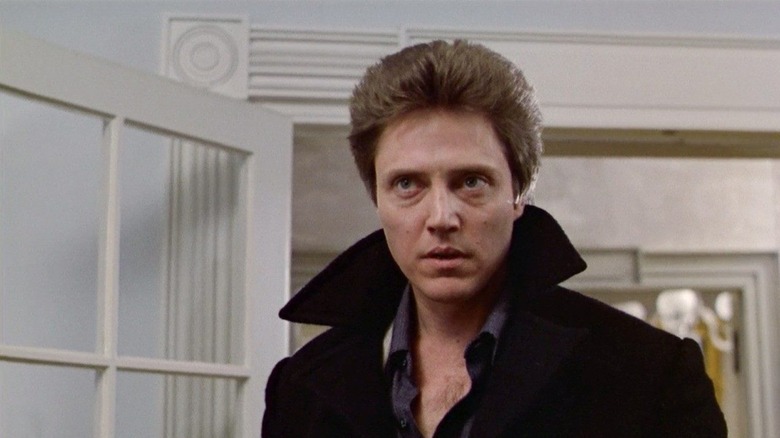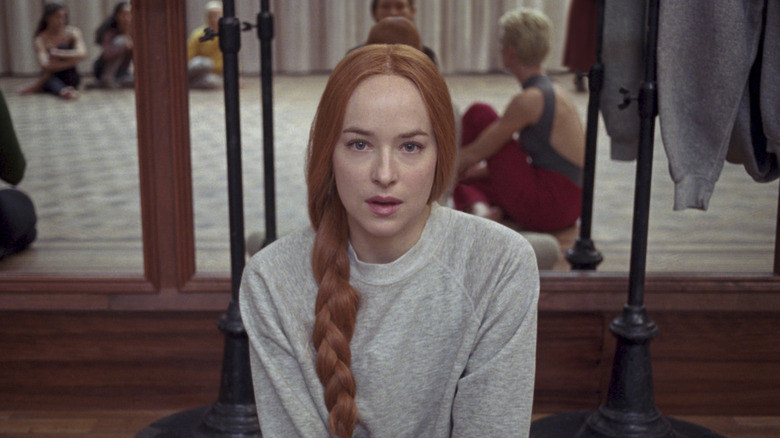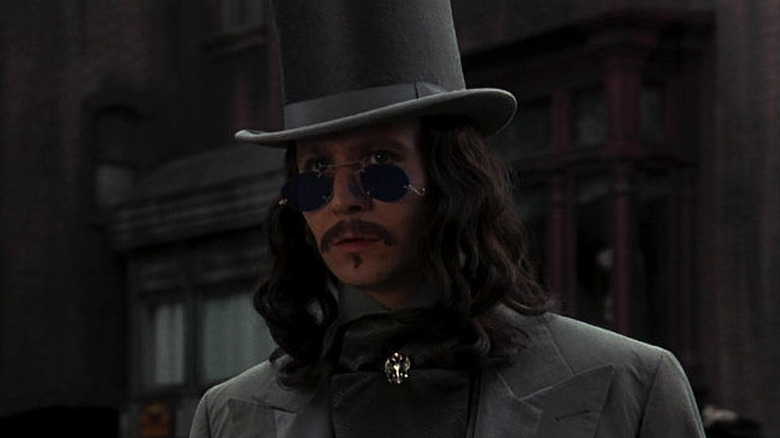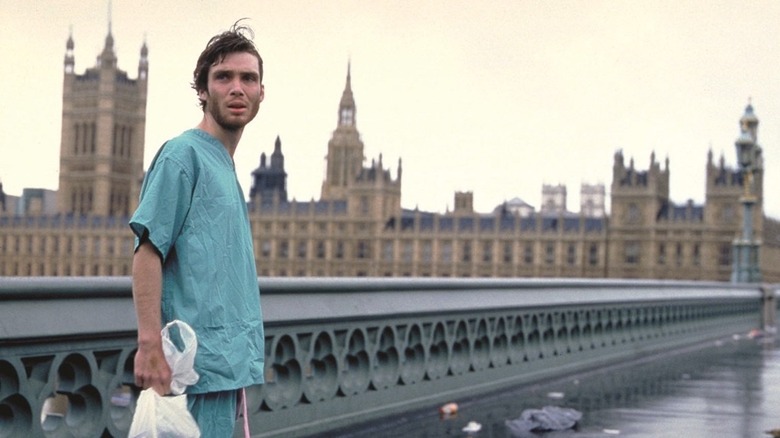Horror Movies Like Night Of The Living Dead You Need To See
George Romero's 1968 black-and-white classic "Night of the Living Dead" is one of the most important films in cinematic history. Romero defined what the zombie would look like in the decades hence. The primal, unrelenting slow moving creatures Romero utilized would be the subject of countless imitators and parodies.
Romero was a master of horror, but also a social critic. The '60s were a frantic period within American history, as the assassinations of key political figures like John F. Kennedy, Bobby Kennedy, Martin Luther King Jr., and Malcolm X had led to an increased public fear of violence. Between race riots, the "red scare," and the emerging Vietnam conflict, viewers had more reason than ever to be anxious. Romero tapped into these fears with his band of survivors, who are constantly questioning who has been infected by the zombie virus.
"Night of the Living Dead" is also a quintessential independent movie. Romero didn't had a small budget, and worked with a loyal group of makeup artists to create practical gore effects. The scaled back approach to societal collapse made the film feel more realistic.
"Night of the Living Dead" fans can also check out these other great horror films.
The Crazies
Romero is most closely linked with zombie movies. After "Night of the Living Dead," he personally helmed five sequels. Each of the subsequent films reimagined the original premise in a new setting, and tackled different social themes. 1978's "Dawn of the Dead" is set within a shopping mall, where Romero had fun lampooning America's consumerism amidst an undead invasion. His underrated 1985 follow up, "Day of the Dead," deconstructed the concept of militarism, as the film's U.S. Army leader (Joseph Pilato) is just as villainous as the zombies.
However, Romero's larger filmography is more vast than just the "Living Dead" series, and he's explored different aspects of horror within his other films. Romero's budgets would get larger as he grew more popular, but his 1973 film "The Crazies" had many of the same low budget constraints that he faced with his first film. The film tackles similar themes of social unrest and paranoia, but contains them within a small suburban town. As a result of the U.S. military's experimentation with biological weapons, the citizens of a closely-knit community begin lashing out at each other with violent murders.
Romero has a similar satirical intent with his commentary on the government's indifference to collateral damage, and "The Crazies" also shows how social barriers break in a time of crisis.
Invasion of the Body Snatchers
The 1955 novel "Body Snatchers" was a landmark piece of sci-fi and horror writing. '50s American sci-fi was often dominated by intergalactic stories of alien invasions and had a more campy vibe, but the concept of invaders replacing normal citizens one-by-one presented a more psychological terror. It tackled many of the same social anxieties that Romero would go on to explore with "Night of the Living Dead."
Action filmmaker Don Siegel helmed the landmark film adaptation "Invasion of the Body Snatchers" one year later, a black-and-white sci-fi horror masterpiece that showed the events from the perspective of scientists researching the aliens' origins. It was an influential film that tapped into the novel's metaphorical intent, but still featured cutting edge visual effects. The film was so beloved that the prospect of a remake felt unnecessary. However, the 1978 reimagining by Philip Kaufman is one of the rare horror remakes that surpasses the original.
Kaufman's version primarily follows two scientists, Matthew Bennell (Donald Sutherland) and Elizabeth Driscoll (Brooke Adams), as they investigate a mysterious biological strain that appears in San Francisco. Bennell is unnerved, as the entity's physiology stems from an alien race that's survived the destruction of its home planet. This species aims to repopulate its home world's population by replacing mankind. Like "Night of the Living Dead," Kaufman creates suspense through subtlety.
Nosferatu
Part of the reason "Night of the Living Dead" is so terrifying is the black-and-white cinematography, which resulted in a stripped down primal story without the flourishes of Hollywood filmmaking. Romero is American, but his inventive independent filmmaking was distinct from anything that major studios had ever produced. Developments in horror filmmaking rely on the work of auteur filmmakers whose unique voices introduce new concepts of what is scary.
F.W. Murnau is one of the earliest landmark artists of horror. Murnau emerged within the 1920s German Expressionist era, a breakthrough movement in filmmaking that highlighted surrealist visuals and personal emotions over the simple recreation of reality. The movement responded to the growing political strife within Germany during the era, similar to Romero's commentary on the changing American dream.
Murnau's 1922 film "Nosferatu" is one of the most influential horror films of all-time; like Romero defined zombies for generations, Murnau introduced the definitive screen adaptation of Bram Stoker's literary vampire Count Dracula. Dracula is one of the most frequently adapted characters in film history; it was only a decade later that Universal Pictures launched their version starring Bela Lugosi, and Christopher Lee's depiction in the Hammer Horror films of the 1950s would become similarly iconic. However, Murnau's version starring Max Schreck was starkly terrifying in a way the later adaptations weren't. With similar black-and-white visuals to "Night of the Living Dead," Murnau's enigmatic vampire story is an actual nightmare.
World War Z
Zombie films are often terrifying when they focus equally on graphic dismemberment and the gradual breakdown of infrastructure and culture. Romero understood this with "Night of the Living Dead," as he showed mankind's indifference to one another amidst a crisis that affected the entire species. Government and military indifference towards actually solving the issue, as well as the characters' own cruel nature, made the humans just as scary as the undead. Romero's zombies are a reflection of what mankind leaves behind; they're doomed to repeat the same mistakes of the past.
Max Brooks's 2006 novel "World War Z" is one of the most notable pieces of zombie literature to emerge in recent years. An anthology collection of various stories set amidst the outbreak of a zombie pandemic, the book captured the scale of the crisis by exploring the perspectives of scientists, military leaders, government figures, and a diverse set of characters from many different cultures and countries. The 2013 film adaptation from director Marc Forster incorporated elements of many of the book's storylines, but centered on a mission by retired UN special agent Gerry Lane (Brad Pitt) to discover the zombies' origins.
Gerry's mission takes him across the globe, and he watches as multiple countries turn on each other as they attempt to isolate their populations. As is common in zombie films, the most dangerous situations stem from human error and indifference, and Gerry is shocked to see the lack of empathy on the frontlines.
Cloverfield
"Night of the Living Dead" was very accessible because of the film's ensemble. Romero knew that audiences would only be willing to accept the film's threat if they were invested in the characters, and he imagined that in a zombie pandemic an untraditional band of survivors would form. Those who wouldn't traditionally associate with each other are forced to survive together, and Romero broke social barriers with the casting of African-American actor Duane Jones as the central protagonist Ben. The large cast also heightened the suspense; not everyone survives, and viewers remained on their toes as they questioned who could perish next.
The groundbreaking 2008 monster horror film "Cloverfield" utilized a compelling ensemble in a similar way to Romero. The film is set amidst a nighttime party in New York City for Rob (Michael Stahl-David). The events are captured using found footage devices, and Rob's friends watch as a kaiju-esque alien monster wreaks havoc on the city. Like "Night of the Living Dead," the first "Cloverfield" doesn't attempt to capture the entire scope of the crisis, but rather focuses on the limited information the characters are privy to. Both films are effective because of their cast of unknowns; having an established movie star may have made the stories feel less realistic.
The guerilla filmmaking techniques Romero utilized for "Night of the Living Dead" were a major stylistic shift from anything audiences had experienced. "Cloverfield" was similarly inventive; it's a rare film that actually utilizes the found footage genre effectively.
Overlord
Zombie films have risked growing stale in the post-Romero years, as many have just attempted to replicate Romero's approach. What made "Night of the Living Dead" effective was its originality; the practical effects, cutting worldview, and bare-bones environments were unique, and the genre has only survived thanks to other new approaches that challenge preconceived expectations for what a zombie film should look like. It's inspiring to see new zombie films that take the concept in different directions, as that feels like the best way to honor Romero's legacy.
The 2018 zombie thriller "Overlord" isn't stylistically similar to "Night of the Living Dead," but it possesses Romero's same spirit of inventiveness. The environment is completely different; the film centers on a battalion of American soldiers who investigate an underground Nazi lair during the heights of World War II. Immediately prior to D-Day, Corporal Lewis Ford (Wyatt Russell) and his team discover that the Germans have been conducting illicit experiments to resurrect the dead. When the creatures break out, the soldiers frantically look for a serum in order to prevent the pandemic from spreading across Europe.
Like "Night of the Living Dead," "Overlord" explores race relations with its African-American protagonist. Private First Class Edward Boyce (Jovan Adepo) is idealistic about the goals of the Allied forces, but he discovers that the military holds many secrets. Just as Ben is accepted by his fellow survivors in "Night of the Living Dead," Edward's heroism is praised by his brothers-in-arms.
The Lighthouse
"Night of the Living Dead" was so effective because of its isolating black-and-white visuals. Modern filmmakers that choose to shoot in black-and-white may do so for purely stylistic reasons, but the most effective directors have utilized the stark visual palette as more than just a tribute to older cinema. Robert Eggers's 2016 directorial debut "The Witch" announced him as an exciting presence, and his 2019 follow up "The Lighthouse" immediately entered the pantheon of modern horror classics.
Set on an isolated New England coastline in the 1890s, "The Lighthouse" follows dock workers Thomas Howard (Robert Pattinson) and Thomas Wake (Willem Dafoe) as they keep their watchtower functioning. Howard joins the older man amidst a crippling storm, and he's immediately offset by Wake's eccentric behavior. Wake loudly sings sailor's yarns, screams in bouts of madness, demands Wake do ridiculous chores, and denies that some events even occurred. Wake descends deeper into madness, and Howard feels his own sanity depleting as he's haunted by seabound creatures, including a seductive mermaid.
Although the tone is more surreal and there is a larger comedic influence, "The Lighthouse" feels indebted to Romero with its sense of isolation. Wake and Howard are constantly questioning each other's motivations; Howard shares the anxieties of being unwelcome that Ben has in "Night of the Living Dead."
The Wicker Man
Folk cult horror and zombie films have a lot in common, as both explore the dissension of humanity into a chaotic and unpredictable state. A zombie virus isn't always clearly explained, and while Romero hints at the outbreak's origins in "Night of the Living Dead," he shows how the extreme pressures force seemingly normal characters to break into unreasonable behavior. Films about cults explore why societies adhere to strict social doctrines that adopt wild practices, and how susceptible people can be drawn to extremist viewpoints when they are vulnerable.
Although the hilariously terrible remake starring Nicolas Cage may have tainted the brand, the original cult classic "The Wicker Man" is one of the finest horror films of the 1970s. The film follows an investigation by Police Sergeant Neil Howie (Edward Woodward) into the disappearance of a young child, who was last sighted in the isolated Summerisle community. Howie discovers that the Summerisle citizens have abandoned Christianity for Paganism, and he grows uneasy learning of their demented practices. While initially welcoming, the small town residents hold foreboding secrets. He gradually realizes that he will not be allowed to leave.
There is a constant state of insecurity in "The Wicker Man" that is reminiscent of "Night of the Living Dead." Like Romero, director Robin Hardy builds to the more extreme moments of brutality by gradually escalating the stakes. Although Christopher Lee's horrifying Lord of the island is the central antagonist, its entire residency turns on Howie.
The Dead Zone
The work of Stephen King is commonly adapted by horror filmmakers. King's unique premises are novel, but he also uses mythological elements to serve a thematic purpose. King's work tends to be very character-driven, but he's also drawn to the same social and political commentary that Romero demonstrates so brilliantly in "Night of the Living Dead." King's 1979 novel "The Dead Zone" begins as an internal body horror struggle, but by the end it becomes a pointed political satire.
The 1983 film adaptation from horror mastermind David Cronenberg follows Johnny Smith (Christopher Walken), a teacher who goes through a traumatic car accident and slips into a coma. When Johnny reawakens five years later, he discovers that his girlfriend Sarah Bracknell (Brooke Adams) has remarried, leaving him more alone than ever. Even more disturbing is Johnny's realization that he has the power to read minds through physical contact. The early sequences show Smith's adjustments to his daily life, as the burden of knowing the latent thoughts of everyone he encounters is overwhelming. However, "The Dead Zone" begins to adopt Romero-adjacent sociopolitical analysis as Johnny discovers a conspiracy within a local election.
Johnny learns that the seemingly perfect United States Senate candidate Greg Stillson (Martin Sheen) is actually a nuclear extremist; he plans to ascend within the U.S. Government and order worldwide nuclear annihilation as President. Cronenberg highlights the same nuclear anxiety that Romero metaphorically hints at in "Night of the Living Dead."
Suspiria
Horror film remakes are not always successful, as Romero fans know very well. Due to a mishap by the distributor, the original "Night of the Living Dead" entered the public domain — and as a result it generated countless remakes, spinoffs, and unsolicited sequels not related to Romero's core series. However, sometimes horror material benefits from a reimagining; the spinoff series "Return of the Living Dead" and Zack Snyder's 2004 remake of "Dawn of the Dead" instilled new life in the "Living Dead" series, showing the saga had potential with filmmakers other than Romero.
Director Luca Guadagnino managed to bring the same fresh take with his 2018 remake of Dario Argento's classic 1977 giallo film "Suspiria." Guadagnino's film took the exact opposite approach of the original. Argento's tight 90 minutes were filled with eccentric characters and bold bright colors, but the remake is an epic two and a half hours with a grey, stark visual palette. The existential dread within Guadagnino's film is closer to the creeping anxiety that Romero crafted in "Night of the Living Dead."
The remake retains the '70s setting, but delves deeper into the Cold War era politics that Romero had tackled in "Night of the Living Dead" as they occurred. Looking at the era in hindsight, Guadagnino explored an international perspective. The film follows brilliant dancer Susan Bannion (Dakota Johnson), who is invited to an elite dance academy in Berlin to train alongside the instructor Madame Blanc (Tilda Swinton).
Bram Stoker's Dracula
"Night of the Living Dead" presents a cruel vision of reality with Romero's deathly seriousness. Many horror films of the '60s were campy, enjoyable crowd pleasers, but Romero wasn't interested in adhering strictly to audience expectations. He delivered an uncompromising depiction of humanity in which compassion was shed in the wake of a crisis. This unflinching tragedy is something legendary filmmaker Francis Ford Coppola retained with his 1992 adaptation of "Bram Stoker's Dracula."
There had already been many "Dracula" films before Coppola took a stab at the material, but his version was distinct with its gothic atmosphere. Gary Oldman stars as the titular character, who is given his curse after renouncing God during his wife's suicide in the 15th Century. The main story picks up four centuries later, where the high-born Jonathan Harker (Keanu Reeves) takes the mysterious Count as his client. Dracula grows infatuated with Harker's new bride Mina (Winona Ryder), who he believes is the reincarnation of his lost love.
Both Romero and Coppola broke from cinematic standards of their respective eras, and both used their nightmarish stories to tackle the current social crisis. In the midst of the HIV/AIDS crisis, Coppola explored the anxieties of contracting a sexually transmitted disease through the characters' fear of being infected by Dracula.
28 Days Later
Romero's depiction of zombies, especially in physical appearance, became so definitive that it took generations for filmmakers to break from his approach. Romero's zombies were slow, creeping figures, but Danny Boyle subverted that image with his highly influential post-apocalyptic thriller "28 Days Later." Boyle and screenwriter Alex Garland introduced fast moving zombies that pile on top of each other, but he retained the character-centric approach that made "Night of the Living Dead" so effective.
"28 Days Later" is set in the immediate aftermath of a global pandemic, where modern London has been completely devastated by an undead invasion. Jim (Cillian Murphy) wakes up from a coma to find the streets completely silent, and forms a hasty alliance with a group of fellow survivors. Like "Night of the Living Dead," the audience only learns of the outbreak's origins through the information that the characters learn, and there is very little exposition.
